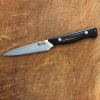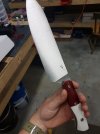You are using an out of date browser. It may not display this or other websites correctly.
You should upgrade or use an alternative browser.
You should upgrade or use an alternative browser.
Recommendation? Chefs knife handle material
- Thread starter BOLD1
- Start date
Stacy E. Apelt - Bladesmith
ilmarinen - MODERATOR
Moderator
Knifemaker / Craftsman / Service Provider
- Joined
- Aug 20, 2004
- Messages
- 36,435
I never had any Micarta that I would call porous. If the surface of Canvas Micarta concerns you, use Linen or Paper Micarta.
Considering it original purpose was an electrical insulator, porosity and soaking up liquids would be a real issue.
I do have an issue with folks making kitchen knives with a thong hole in the handle (to hang on a hook?). All sorts of stuff can get in that hole.
Considering it original purpose was an electrical insulator, porosity and soaking up liquids would be a real issue.
I do have an issue with folks making kitchen knives with a thong hole in the handle (to hang on a hook?). All sorts of stuff can get in that hole.
- Joined
- Aug 24, 2012
- Messages
- 208
How bout corian? I use it often on kitchen knives.
- Joined
- May 31, 2016
- Messages
- 485
Yeah. Any of the solid surface materials work great.How bout corian? I use it often on kitchen knives.
- Joined
- Oct 3, 2002
- Messages
- 12,297
Half the kitchen knives we're making here now use old linen micarta. Not a problem.
Have you checked out Richlite as an option? There aren’t quite as many color choices as G10 or Micarta but the list has gotten longer over the last couple of months. It is essentially a paper micarta type material that has been used in cutting boards and countertops for some time. I buy mine at Masecraft Supply Co. I have made a few knives with it so far and it is easier to work than G10 and buffs nicely after sanding to 800 grit. Here is a paring knife I recently made with black and grey layered Richlite.


Have you checked out Richlite as an option? There aren’t quite as many color choices as G10 or Micarta but the list has gotten longer over the last couple of months. It is essentially a paper micarta type material that has been used in cutting boards and countertops for some time. I buy mine at Masecraft Supply Co. I have made a few knives with it so far and it is easier to work than G10 and buffs nicely after sanding to 800 grit. Here is a paring knife I recently made with black and grey layered Richlite.
Nice looking paring knife.
I thought it was interesting the different thickness that it's available in.
FWIW Ever seen the funk and gunk that gathers in the grooves on the handle of a Dexter Russell Sanisafe handle, which they love, or check the cullens on the blade where stuff can be also.
I've seen scary stuff come out of commercial kitchens.
Waaaaay back when I cleaned a meat cutting room I always used to miss the buildup where the handle meets the blade on the Victorinox boning knives. It wouldn't come off when it was fresh but it'd chip off with a fingernail in the morning.
- Joined
- Oct 14, 1998
- Messages
- 2,129
Over the weekend I thought of a simple test to check how micarta is affected by fluids.
I placed a block of natural canvas micarta in a cup of water. Green food coloring was added to the water. Approximately 2 inches of block was above the water. After placing the block in the water, photos were taken after 1 hour, 2 hours and 24 hours. The cup with the water and block was not moved.
Photo 1: Capillary action has started pulling water up the block.

Photo 2: Capillary action continues and food coloring is visible.

Photo 3: Capillary action has pulled enough water to clearly see the food coloring.

Chuck
I placed a block of natural canvas micarta in a cup of water. Green food coloring was added to the water. Approximately 2 inches of block was above the water. After placing the block in the water, photos were taken after 1 hour, 2 hours and 24 hours. The cup with the water and block was not moved.
Photo 1: Capillary action has started pulling water up the block.

Photo 2: Capillary action continues and food coloring is visible.

Photo 3: Capillary action has pulled enough water to clearly see the food coloring.

Chuck
Robert Erickson
Knifemaker / Craftsman / Service Provider
- Joined
- Feb 2, 2014
- Messages
- 2,814
Interesting Chuck. Did you cut the block in half to see what the penetration looked like?
Hengelo_77
Basic Member
- Joined
- Mar 2, 2006
- Messages
- 5,966
interesting, how deep does it penetrate?
- Joined
- Feb 19, 2018
- Messages
- 660
Over the weekend I thought of a simple test to check how micarta is affected by fluids.
I placed a block of natural canvas micarta in a cup of water. Green food coloring was added to the water. Approximately 2 inches of block was above the water. After placing the block in the water, photos were taken after 1 hour, 2 hours and 24 hours. The cup with the water and block was not moved.
Photo 3: Capillary action has pulled enough water to clearly see the food coloring.

Chuck
Such a cool experiment! Thanks for running it and posting pics.
In retrospect, it would seem to make sense if the resin doesn't fully penetrate the canvas or whatever is used for the composite, then it would be an entryway for liquid into the material. I wonder how much it changes dimensionally though, is it actually expanding a measurable amount?
Stromberg Knives
strombergknives.com
- Joined
- Jan 3, 2015
- Messages
- 856
I really enjoy working with Micarta. And I think it's a great material for kitchen knives. I've never seen my Micarta handles get damaged from kitchen use. Bear in mind that my knives only get used in home kitchens.




Chuck - your experiment agrees with the results of "blistering" problems in fiberglass boats found during the 80's and 90's After years of testing, lawsuits, claims and counterclaims, it was found that osmosis allowed water to pass through the gelcoat and into the layers of fiberglass. Once inside the layup, the water reacted with the chemicals in the polyester resin and caused blisters. The cure was to layup 1 or 2 layers of matt with vinylester resin next to the gelcoat. This made a waterproof layer to prevent the water from reaching the polyester resin and woven roving layers. Later boats, particularly those which stayed in the water all the time, were layed up with 100% vinylester resin.
I thought people loved Micarta most for grip , when micarta is wet grip is even better . . . .Over the weekend I thought of a simple test to check how micarta is affected by fluids.
I placed a block of natural canvas micarta in a cup of water. Green food coloring was added to the water. Approximately 2 inches of block was above the water. After placing the block in the water, photos were taken after 1 hour, 2 hours and 24 hours. The cup with the water and block was not moved.
Photo 1: Capillary action has started pulling water up the block.

Photo 2: Capillary action continues and food coloring is visible.

Photo 3: Capillary action has pulled enough water to clearly see the food coloring.

Chuck
- Joined
- Dec 24, 2005
- Messages
- 831
I respect Chuck’s opinion and have done for years. I feel the test only shows a rough surface promotes capillary action. The same test with sanded back and polished surfaces would not show the same results. The front and back of the block (uncut factory surfaces) don’t show any seepage.
It is finished. I ended up getting some paper micarta and OD green G10 liner/spacer, and brass corby bolts. I got some more information and the promotion he got is in the Army and she asked for the Army insignia. Blade is AEBL hardened to a HRC 62. Any way I just wanted to share and say thanks to all the imput.







